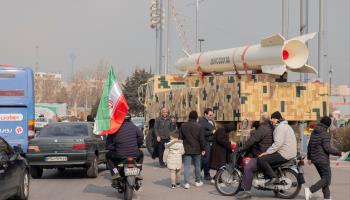Iran has undertaken a number of military exercises and unveiled more military hardware in recent weeks
Supreme Leader Ali Khamenei said on February 12 that Iran should further develop its military capabilities. Events in the last ten months have revealed weaknesses in Iran’s multi-layered capabilities intended to deter Israeli and US threats against its nuclear and missile programmes and military industries. In response, Iran has significantly increased its military activities.
What next
Subsidiary Impacts
- Any diplomatic talks are unlikely to resolve Western concerns about Tehran’s long-range missile programme and network of non-state allies.
- Security forces will continue to clamp down on internal protests, which the leadership fears could destabilise the Islamic Republic.
- Tehran will find it difficult to rebuild relations with the new government in Syria, undermining its defence depth against Israel.
Analysis
Iran’s multi-layered deterrence strategy is based on defensive elements, such as air defence systems, and offensive capabilities. The latter includes:
- medium-range missiles;
- allied groups such as Hezbollah, Hamas and Shia militia based in Iraq; and
- an anti-access/area denial (AA/AD) capability at the strategically important Strait of Hormuz and more recently the Bab al-Mandab strait, the latter using their Huthi allies (see ISRAEL/LEBANON: A fragile truce will set in – December 6, 2024, see PALESTINIANS/ISRAEL: Sustained truce may be difficult – January 21, 2025 and see YEMEN: Huthis manage economic impact of strikes – December 18, 2024).
Events since April 2024 have revealed capability weaknesses that undercut defence and deterrence. Iran did not extend its air defence umbrella to its regional allies, while its homeland air defence failed to counter an air-launched ballistic missile attack by Israel (see ISRAEL: Strikes will constrain Iran’s capacity to act – October 28, 2024). Tehran’s position was weakened by the collapse of the Assad regime, its longstanding ally, in neighbouring Syria (see SYRIA: De facto leader will prioritise pragmatism – January 13, 2025).
Although Iran was able to launch hundreds of one-way attack drones and ballistic and cruise missiles at Israel, these were no match for Israel’s air defence capabilities (see IRAN/ISRAEL: All-out war could follow Iran strikes – October 2, 2024).
Critical juncture
Iran’s government faces an ascendant Israel and a hostile United States under President Donald Trump, presenting a difficult choice: to offer concessions regarding its nuclear (and perhaps missile) programme in order to reduce regional tensions, or to persist with its defiant stance (see IRAN: Foreign policy direction is highly uncertain – January 20, 2025). The latter would involve a combination of:
- rebuilding its regional proxy networks; and
- developing more capable weapons, including supersonic anti-ship missiles, long-range hypersonic ballistic missiles and even nuclear warheads.
These capabilities would underscore Iran’s latent threat to oil and gas infrastructure and shipping in the Gulf, though Tehran’s determination to preserve detente with the Gulf states obliges it to tread carefully.
Iran’s choices are defiance or concession
Diplomatic overtures to Washington by President Masoud Pezeshkian appear to have stalled after Khamenei, on February 7, publicly rejected direct contact with Washington (see IRAN: A new nuclear deal is a distant prospect – February 10, 2025). However, a parallel negotiation pathway controlled directly by Khamenei could be secretly discussing the terms of future negotiations with the United States and/or European powers.
Perceived threats
The Iranian government perceives military and security threats from a number of sources.
Israel, not the United States, is the main military threat
Iran has been effectively at war with Israel since 1982, with occasional periods of escalation, often through regional allies but more recently also directly. Israel views Iran’s nuclear and missile programmes as existential threats. Over the past decade, it has carried out covert operations, cyberattacks and assassinations targeting Iranian nuclear and missile scientists. More recently, Israel has targeted Iranian military facilities in Syria and military sites inside Iran.
Tehran does not perceive Washington’s regional presence as a real threat. However, it considers Washington’s unwavering support for Israel as a major block to its core policy of eroding Israel out of existence. Iran also views US airpower as a potential threat against its nuclear and missile programmes.
Iran perceives the threat from European countries as purely political. However, at present, Tehran is worried that Europe is having a toughening effect on US policies towards Iran, and is also determined to push for the snapback of UN sanctions because Iran’s lack of cooperation with the International Atomic Energy Agency (IAEA) (see IRAN: Talks about the nuclear issue are possible – February 7, 2025).
Military preparedness
In recent weeks Iran has conducted a series of military and security exercises in order to restore its deterrence and improve its defensive posture.
Tehran has unveiled a number of military advances
In those exercises, Tehran showcased:
- new short-range air defence systems, including a new ground-based laser, deployed to defend the nuclear sites against attack;
- short- to medium-range air defence systems to defend against “bunker-busting smart munitions”;
- an improvement in foot soldiers’ personal gear, individual weapons and land-warfare tactics;
- a large underground ballistic missile base; and
- a new medium altitude long-endurance (MALE) unmanned aircraft system with an operational radius of 2,000-4,000 kilometres and which can carry up to 13 small bombs or missiles.
Air force
Iran’s air force suffers more than its other services from ageing equipment. Isfahan air base has about ten F-14A Tomcats; at most four are considered fully operational. Iran has only a handful of operational AIM-54 Phoenix long-range air-to-air missiles but has developed medium-range (80-160-kilometre) Fakoor missiles for its Tomcats. Other F-4E and F-5E fighters on scramble duty at other air bases still use old shorter-range missiles.
To mitigate the shortage of capable fighter jets Iran has developed a rocket-launched jet-powered target drone armed with a short range air-to-air missile.
In late 2023, Russia agreed to sell Iran 50 modern multi-role Su-35s, plus a handful of Yak-130 advanced lead-in jet trainers. Two Yak-130s have arrived, as have two unassembled Su-35s, with a debut flight scheduled for 2026.
Iran plans eventually to activate three Su-35 squadrons of 16 aircraft each in Isfahan, Hamedan and possibly Tabriz. A few Su-35s could rotate between Iran’s new underground air bases, such as Oghab-44 air base. However, while Russia’s output of Su-35s has increased in the last year, Moscow might hesitate to deliver a sizeable order for fear of antagonising the Gulf states or Washington, for at least as long as the opportunity exists to improve those relationships.
Air defence
Iran took delivery of a S-300 air defence system from Russia in 2016 and has developed indigenous air defence systems during the past decade. However, the systems were found wanting in October 2024, when Israel successfully removed some of Iran’s air defence systems and solid propellant missile-related industrial sites deep inside Iran.
Nevertheless, the damage to Iran’s air defence system should not be exaggerated. Recent satellite imagery suggests that while two S-300 sites remain non-operational they were not destroyed. Numerous air defence systems remain in place.
Concerns over a vulnerability to standoff airborne ballistic missiles prompted the Islamic Revolution Guard Corps (IRGC) to accelerate development of a missile defence system.
Navy
The IRGC Navy operates heavily armed (including anti-ship missiles) speedboats with top speeds of 100 knots, a large arsenal of coastal missile batteries, sea mines, drones and a large number of explosive-laden unmanned surface vessels (USVs) and unmanned underwater vehicles (UUVs). A USV can carry large explosive payloads, but they are also heavy and difficult to manoeuvre, unless they attack their target in swarms.
In recent weeks, the Navy has unveiled:
- an underground gunboat base;
- a first signal intelligence spy ship; and
- a drone and helicopter carrier.
A large-scale IRGC Navy AA/AD exercise was held on January 24-25. It involved coordinated assaults by fast gunboats and missile boats and coastal missile batteries in the northern and central Gulf.



